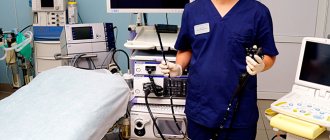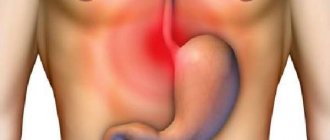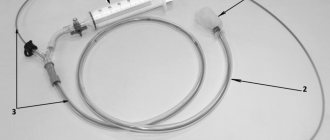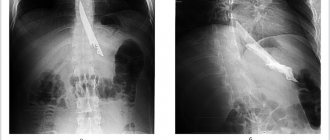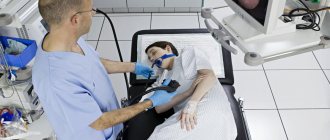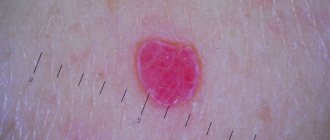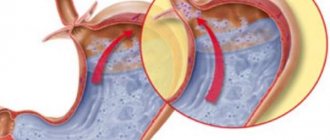Functional research methods in gastroenterology have been introduced into the work of the Central Clinical Hospital "RZD-Medicine" since 2021 within the framework of the laboratory of functional research methods in gastroenterology of the Moscow State Medical University named after. A.I. Evdokimov.
The following types of functional research methods are carried out in the laboratory:
- High-resolution esophageal manometry (test code 69.001.003);
- 24-hour pH/pH impedance measurement of the esophagus (test code 69.001.004).
For patients: Preparation for esophageal manometry
Full text of the article:
Preparation for esophageal manometry
Description of the study: the study is carried out for 20-30 minutes and includes installing a probe and taking 10 sips of water, each with a volume of 5 ml. While the patient is swallowing water, the doctor assesses the motor function of the esophagus.
The study is carried out on a device from MMS (the Netherlands) by a gastroenterologist.
Before inserting the probe, the doctor must find out the symptoms the patient has, what treatment is currently being carried out, and the presence of allergic reactions.
The probe is inserted through the nose in a sitting position, if necessary, under local anesthesia (10% lidocaine aerosol, 1 injection into each nostril). Before insertion, the tip of the probe is lubricated with a gel based on a local anesthetic (for example, cathegel with lidocaine). The diameter of the probe for manometry does not exceed 5 mm. The probe is flexible and soft.
When inserting a catheter into the nose, the patient is asked to throw back his head and slowly rotate through the upper or lower nasal passage into the oropharynx, which is felt as a feeling of “failure”. At this moment, the patient may feel minor discomfort in the nose, sneeze, and mucus may leak from the nose.
Next, the patient is asked to tilt his chin to his chest and begin swallowing movements, during which the examiner gradually moves the probe deeper. To facilitate the administration procedure, the patient is asked to drink water through a straw or a disposable syringe. At this moment, vomiting and coughing are possible.
After the probe passes the level of the epiglottis, the unpleasant sensations disappear, leaving only the sensation of a foreign body in the esophagus. The doctor asks the patient to say a few words in a loud voice to prevent the catheter from getting into the respiratory tract (in this case, the patient will not be able to speak due to irritation of the vocal cords, but will cough).
If the probe is inserted correctly, the discomfort disappears soon after installation.
The probe is inserted to a depth of 40-60 cm (depending on the purpose of the study and the location of the lower esophageal sphincter). The free end of the probe is connected to the measuring apparatus.
Next, the patient is asked to take a horizontal position and given 5 ml of water to drink through a disposable syringe without a needle.
Preparation for esophageal manometry
The insertion of the probe should be done on an empty stomach.
8-12 hours before the test, the patient should not eat or drink to reduce the risk of vomiting and aspiration (especially if achalasia is suspected).
48 hours before the procedure, medications that affect the motor activity of the esophagus (nitrates, calcium channel blockers, prokinetics, anticholinergic drugs) are discontinued (if the patient’s condition allows).
Before the study, please read the contraindications for it. Do you have the following diseases?
- ulcers of the esophagus and stomach with the threat of bleeding;
- varicose veins of the esophagus II-IV degree;
- recent (less than 3 months) surgical interventions or bleeding from the upper gastrointestinal tract;
- burns, diverticula, decompensated strictures of the esophagus;
- persistent cough or vomiting;
- aortic aneurysm;
- severe forms of hypertension and ischemic heart disease;
- nasopharyngeal obstruction;
- maxillofacial injuries;
- severe forms of coagulopathies;
- malignant neoplasms of the esophagus and stomach;
- mental illness.
Esophageal manometry
Esophageal manometry is an outpatient test used to look for abnormalities in movement and pressure in the esophagus that can lead to problems such as heartburn. The esophagus is a “tube” leading from the mouth to the stomach. Manometry determines the strength and coordination of esophageal contractions during swallowing.
During manometry, a tube passes through the nose, along the back of the throat, through the esophagus and into the stomach.
Who is esophageal manometry indicated for?
Esophageal manometry should be performed in patients with the following complaints:
- Difficulty swallowing
- Heartburn or reflux
- Chest pain
What is the working principle of esophageal manometry?
Food moves from the pharynx to the stomach through wave-like contractions of the esophagus called peristalsis. Manometry will show how effectively the esophagus can perform peristalsis. Manometry also allows the doctor to check the muscle valve that connects the esophagus to the stomach, the lower esophageal sphincter, or LES. This valve relaxes to allow food and liquid to enter the stomach. It closes to prevent food and liquid from flowing back into the esophagus from the stomach.
Impaired peristalsis and LES function may cause symptoms such as difficulty swallowing, heartburn, or chest pain. The information obtained from manometry helps the doctor identify the problem. This information is also very important for antireflux surgery.
What happens before esophageal manometry is performed?
If you are pregnant, have heart or lung problems or other medical problems or illnesses, or are allergic to any medications, be sure to tell your doctor before having an esophageal manometry test.
Can I continue taking my medications before having an esophageal manometry test?
List of drugs that may affect the results of the study:
- Proton pump inhibitors (Prilosec, Prevacid, Aciphex, Protonix, Nexium)
- H2 blockers (such as Pepcid and Zantac)
- Antacids (such as Tums and Maalox)
- Calcium channel blockers (eg Procardia and Cardizem)
- Nitrates (eg Isordil and nitroglycerin)
- ß-blockers (eg Inderal and Corgard)
- Caffeine
It is very important to discuss all medications you are taking before the test with your doctor.
Do not stop taking any medications without first consulting your doctor.
Can I eat or drink before an esophageal manometry test?
Do not eat or drink anything for eight hours before the test.
What happens during esophageal manometry?
You are not sedated during esophageal manometry; Local anesthetics (painkillers) may be used by applying them to the nasal mucosa to ensure more comfortable passage of the tube.
A small flexible tube passes through the nasal cavity, down the esophagus and into the stomach. The tube does not interfere with breathing. When placing the tube, you are in a sitting position. The tube is connected to a machine that records the contraction of the esophageal muscles in the form of a graph.
You may feel some discomfort while the tube is inserted, but the process only takes about a minute. Most patients quickly become accustomed to the presence of the tube. Vomiting or coughing may occur when the tube is inserted, but is rare.
Once the tube is in place, you will be asked to lie on your left side.
A small sensor records every swallowing movement. During the test, you will be asked to take a certain number of sips of water.
The tube is slowly removed. A gastroenterologist (a doctor who specializes in diseases of the gastrointestinal tract) evaluates the esophageal contractions recorded during the test.
The study lasts from 30 to 40 minutes.
What happens after esophageal manometry?
- You can continue your normal diet and activity after esophageal manometry.
- You may experience temporary soreness in your throat. Rinsing with water and salt may help.
Cautions regarding esophageal manometry
If you experience any unusual symptoms or side effects after an esophageal manometry test, call your doctor or go to an emergency room right away.
High-resolution manometry in the diagnosis of motor function disorders of the esophagus
Magazine “Medical Council.
Gastroenterology" No. 3, 2018 E.V.
Barkalova, Yu.A. Kucheryavyi, Ph.D., I.V. Maev , Doctor of Medical Sciences, Professor
Moscow State Medical and Dental University named after.
A.I. Evdokimova, Ministry of Health of the Russian Federation, Laboratory of Functional Research Methods in Gastroenterology, Moscow High-resolution esophageal manometry is a modern research method that is used throughout the world as the “gold standard” for assessing esophageal motility. For the purpose of interpreting manometric data, the Chicago classification is used. It provides a standardized approach to the analysis and classification of motor disorders, which facilitates their diagnosis and helps in choosing treatment tactics. There are four main categories of movement disorders: 1. Disorders with impaired patency of the esophagogastric junction (achalasia types I, II, III, obstruction of the esophagogastric junction). 2. Major disturbances of peristalsis (distal esophagospasm, hypercontractile esophagus, lack of contractility). 3. Minor peristalsis disorders (ineffective motility, fragmented peristalsis). 4. Normal esophageal motility. The Chicago classification includes only primary motor disorders. Motor disorders of the upper esophageal sphincter and features of motility after surgical interventions on the esophagus do not have classification criteria. However, in the future we should expect improvements and expansion of the Chicago classification also in relation to these conditions.
EV Barkalova, Yu.A. Kucheryavy
, PhD in medicine,
IV Maev
, MD, Prof.
AIYevdokimov Moscow State University of Medicine and Dentistry of the Ministry of Health of the Russian Federation, Laboratory of Functional Methods of Diagnosis in Gastroenterology, Moscow
High-resolution manometry in the diagnosis of oesophageal motility disorders
Esophageal high-resolution manometry is a modern method of diagnosis performed worldwide as the gold standard for assessing esophageal motility. The Chicago classification is applied to interpret the manometric findings. It provides a standardized approach to the analysis and classification of motility disorders, which facilitates a diagnosis of esophageal motility disorders and helps select a tactic for treatment. There are four major categories of motility disorders: 1. Disorders with esophagogastric junction outflow obstruction (types I, II, III achalasia, esophagogastric junction outflow obstruction). 2. Major disorders of peristalsis (distal esophageal spasm, jackhammer esophagus, absent contractility). 3. Minor disorders of peristalsis (ineffective motility, fragmented peristalsis) 4. Normal esophageal motility. Only primary esophageal motility disorders are addressed in the Chicago Classification. Motility disorders of the upper esophageal sphincter, motility abnormalities after surgical esophagus interventions do not have classification criteria. However, in the future the Chicago classification is expected to be improved and expanded to cover these disorders.
Upload file
Bibliography
1. Clouse RE, Staiano A. Topography of the esophageal peristaltic pressure wave. Am J Physiol, 1991, 261(4 Pt 1): G677-84.
2. Gyawali C.P. High resolution manometry: the Ray Clouse legacy. Neurogastroenterol Motil, 2012, 24(Suppl 1): 2-4.
3. Fox MR, Bredenoord AJ. Oesophageal high-resolution manometry: moving from research into clinical practice. Gut, 2008, 57(3): 405-23.
4. Rohof WOA and Bredenoord AJ. Chicago Classi fi-cation of Esophageal Motility Disorders: Les sons Learned. Curr Gastroenterol Rep, 2021, 19(8): 37.
5. Storonova O.A., Trukhmanov A.S. Methods for studying the motor function of the esophagus. Manual for postgraduate education. Ed. acad. RAMS, prof. V.T. Ivashkina. M. 2011: 36 s
6. Kahrilas P, Bredenoord A, Fox M, Gyawali C, Roman S, Smout A, Pandolfino J. The Chicago Classification of esophageal motility disorders, v3.0. Neurogastroenterol. Motil., 2015, 27: 160-174.
7. Ivashkin V.T., Trukhmanov A.S., Godzello E.A. and others. Recommendations of the Russian Gastroenterological Association for the diagnosis and treatment of achalasia cardia and cardiospasm. RZHGGK, 2021, 26(4): 36-54
8. Rohof WO, Salvador R, Annese V, Bruley des Varannes S, Chaussade S, Costantini M et al. Outcomes of treatment for achalasia depend on manometric subtype. Gastroenterology, 2013, 144(4): 718-25.
9. Francesco T, Alexandros I, Francesco A, Franco B. Treatment of achalasia in the era of high-resolution manometry. Ann Gastroenterol, 2015, 28(3): 301-308.
10. Zhang W, Linghu EQ. Peroral endoscopic myotomy for type III achalasia of Chicago classification: outcomes with a minimum follow-up of 24 months. J Gastrointest Surg 2021, 21(5): 785-791.
11. Van Hoeij FB, Smout AJ, Bredenoord AJ. Characterization of idiopathic esophagogastric junction outflow obstruction. Neurogastroenterol Motil, 2015, 27(9): 1310-6.
12. Perez-Fernandez MT, Santander C, Marinero A, Burgos Santamaria D, Chavarria-Herbozo C. Characterization and follow-up of esophago-gastric junction outflow obstruction detected by high resolution manometry. Neurogastroenterol Motil, 2021, 28(1): 116-26.
13. Porter RF, Gyawali CP. Botulinum toxin injection in dysphagia syndromes with preserved esophageal peristalsis and incomplete lower esophageal sphincter relaxation. Neurogastroenterol Motil, 2011, 23(2): 139-44.
14. Cattau EL Jr, Castell DO, Johnson DA, Spurling TJ, Hirszel R, Chobanian SJ et al. Diltiazem therapy for symptoms associated with nutcracker esophagus. Am J Gastroenterol 19981, 6(3): 272-6.
15. Orlando RC, Bozymski EM. Clinical and mano-metric effects of nitroglycerin in diffuse esophageal spasm. N Engl J Med 1973, 289(1): 23-5.
16. Vanuytsel T, Bisschops R, Farre R, Pauwels A, Holvoet L, Arts J et al. Botulinum toxin reduces dysphagia in patients with nonachalasia primary esophageal motility disorders. Clin Gastroenterol Hepatol, 2013, 11(9): 1115-21.
17. Khan MA, Kumbhari V, Ngamruengphong S, Ismail A, Chen YI, Chavez YH et al. Is POEM the answer for management of spastic esophageal disorders? A systematic review and meta-analysis. Dig Dis Sci, 2021, 62(1): 35-44.
18. Bechara R., Ikeda H., Inoue H. Peroral endoscopic myotomy for Jackhammer esophagus: to cut or not to cut the lower esophageal sphincter. Endosc Int Open, 2021, 4(5): E585-8.
19. Goel R, Anggiansah A, Wong T, Wilkinson M. A Jackhammer in the gullet: high amplitude oesophageal contractions as a cause of atypical chest pain. BMJ Case Rep, 2015, 5.
20. Yun S, Yang W, Rhee P. Two distinct types of hypercontractile esophagus: classic and spastic Jackhammer. Gut and Liver, 2021, 10(5): 859-863.
21. Maev I.V., Barkalova E.V., Ovsepyan M.A., Kucheryavyi Yu.A., Andreev D.N. Possibilities of pH-impedansometry and high-resolution manometry in the management of patients with refractory gastroesophageal reflux disease. Therapeutic Archives, 2021, 89(2): 76-83
Esophago-PH-metry
Esophago-PH-metry is a modern diagnostic test to measure the reflux of acidic stomach contents into the esophagus.
In PH testing, a thin probe, about 1.5 mm in diameter, is inserted into the esophagus through the nose or mouth. At the tip of the probe there is a pH sensor. After insertion, the probe is secured to the nose with a patch and remains in the esophagus for 24 hours. The probe is connected to a small, portable receiver that records the sensor readings. During the entire measurement, a person leads a normal life: eats, walks or works. The patient is asked to write down what he ate, drank, what medications he took, when and what complaints were observed. At the end of the examination, the recorded data is transcribed and compared with the compiled records.
A few days before the procedure, you should stop taking medications that suppress acid production and esophageal motility. pH-metry, like esophagometry, is performed on an empty stomach.
Cost of manometry in Germany
Prices for manometry of the esophagus, rectum and stomach at the Nordwest clinic can be clarified by calling 8 800 551 8099. As a rule, the procedure is prescribed by the attending physician as part of the diagnosis and treatment of gastroenterological diseases. If you want to undergo a set of preventive examinations to check the health of the digestive tract, pay attention to the Nordwest Hospital program “Gastroenterological check-up in Germany”. Patients from all over Russia and the CIS countries come to us to undergo a medical examination under the supervision of highly qualified German specialists. Our patients regularly post their reviews about manometry and other types of examination, as well as about the treatment they received in the clinic on social networks or send by email
Performing esophageal manometry procedure
Manometry does not require any anesthesia. During the procedure, the patient is in a lying position. A special probe is inserted through his nose, and a special gel is injected into the mucous membrane of the nose and throat, which neutralizes sensitivity and also suppresses the gag reflex. During the process, the patient is asked to perform swallowing movements and also drink a small amount of water. The results of the diagnostic procedure are displayed on the computer screen and subsequently analyzed by diagnosticians. Typically, esophageal manometry takes about 20-30 minutes.
Additional services for foreign patients
The Elite Medical clinic offers each patient a completely new approach to medical tourism in Israel. Now, in addition to diagnostic and therapeutic services, our clinic offers to purchase a set of additional services that will completely relieve you of all everyday problems and allow you to concentrate exclusively on the process of treatment and diagnosis.
The complex includes the following services:
- ordering air tickets;
- meeting the patient at the airport and booking a hotel room;
- purchasing a local SIM card;
- support by an experienced curator with a medical education;
- support by a qualified translator;
- translation of all medical documents;
- transportation support, which includes transfers from the airport to the hotel, as well as from the hotel to the clinic for the necessary procedures.
The complex costs $400, and this amount is paid once: if you need to stay in Israel for a longer period, no additional expenses are required.
Parameters that are measured during esophageal manometry
- When conducting a study of the lower esophageal sphincter, resting pressure is measured, and the relaxation of the organ during swallowing of water is assessed (residual pressure, percentage and duration of relaxation). In addition, the location of the NPS and its total length are determined.
- When manometry of the body of the esophagus, the amplitude, duration and speed of contractions of the organ are measured. Amplitude measures how closely the muscles of an organ are squeezed during contraction, duration measures how long the muscles remain contracted during contraction, and velocity measures the spread of contraction down the organ.
- Manometry of the upper esophageal sphincter, like the LES, examines the following parameters: resting pressure, percentage of relaxation, and duration of relaxation.
Anorectal manometry
Anorectal manometry (rectal manometry) is a test that measures the function of the anal sphincter.
Prescribed to clarify the diagnosis for patients with stool incontinence, bowel movement disorders and chronic constipation. Also used to monitor results after surgery and the course of treatment.
During the procedure, the patient is positioned on the left side. A thin probe with an inflatable balloon at the end is inserted 10 cm through the anus into the rectum. The balloon is inflated and thus stimulates the urge to defecate. By pulling out the inflated and then empty balloon, anal pressure is measured. The patient is asked to cough several times.
These studies show dysfunction of the anal sphincter. This procedure does not require special preparation, is well tolerated and proceeds without complications.
